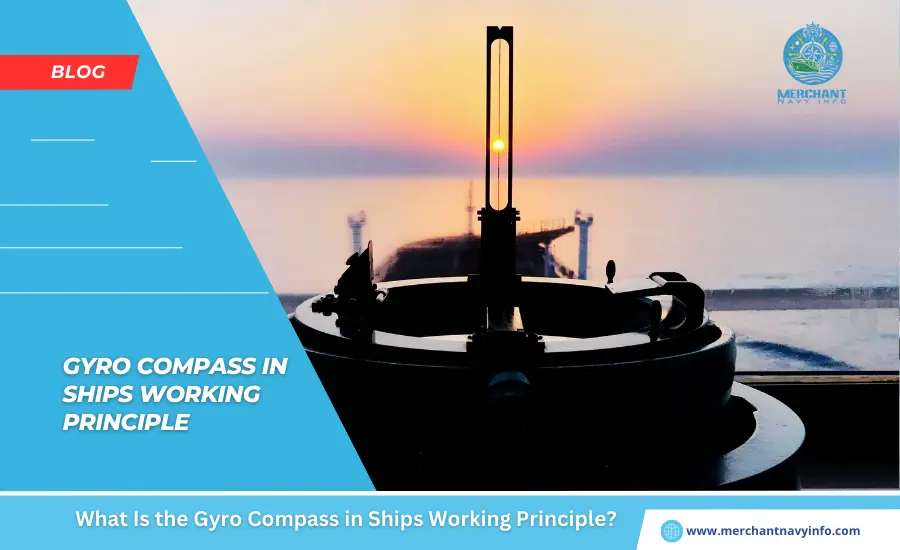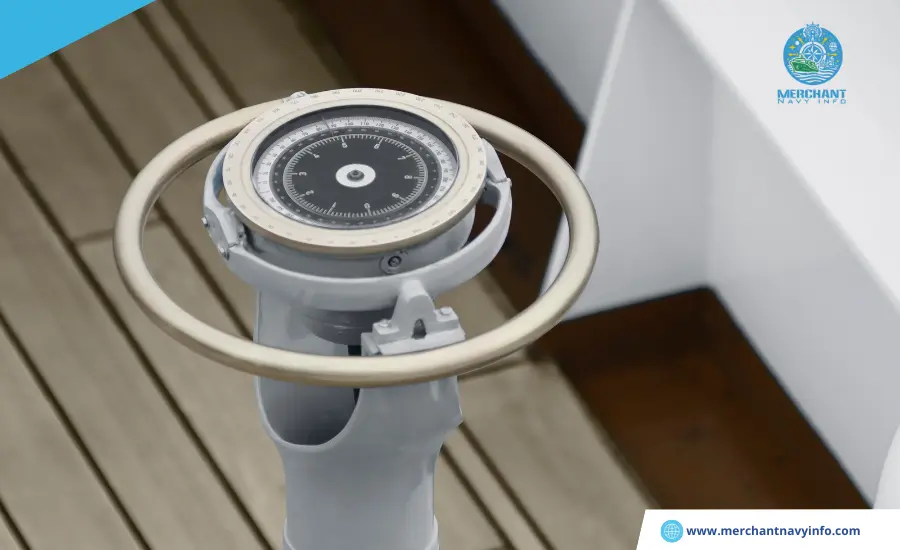
A gyro compass in ship is a type of gyroscope commonly used on ships. Among other things, it uses an electrically powered, rapidly rotating gyro wheel and frictional forces to determine true north. He uses basic physical laws, the effects of gravity, and the rotation of the Earth.
Structure of a Gyrocompass
The gyro compass in ship has become an essential piece of equipment on almost all merchant ships and warships. As it can determine the direction of true north instead of magnetic north. It consists of the following units:
Main Compass
Uses a gyroscope to determine and maintain true north.
Repeating Compass
Receives and displays the true direction electrically transmitted from the main compass.
Course Recorder
It continuously records the manoeuvres on a movable piece of paper.
Control Panel
It controls the electrical operation of the system and determines its operating condition by means of suitable measuring devices.
Voltage Regulator
It provides constant power to the ship’s motor generators.
Alarm Unit
It indicates a loss of vessel supply.
Amplifier Field
It controls the following systems:
Motor-generator
Converts the ship’s DC power into AC power and powers the compass equipment. Gyrocompasses are connected to the relay compass through a transmission system. The rapidly spinning rotor weighs between 1.25 and 55 pounds. It is driven by another electric motor that rotates at several thousand revolutions per minute. However, the most important part of the gyro compass in ship system is the spinning wheel, called the gyroscope.
How A Gyrocompass Works

External magnetic fields that deflect a normal compass cannot affect a gyrocompass. When a ship changes course, an independently powered structure called the “phantom” moves with it. But the rotor system continues to point north.
This misalignment sends a signal to the drive motors to move the Phantom. Along with the rotor system, back on a path that might have moved. The Phantom by just one or a few degrees of the compass circle. Once aligned, the Phantom repeatedly sends an electrical pulse to the compass for each degree of movement.
The gyrocompass’s gyroscopes are mounted so that they can move freely about to three mutually perpendicular axes. And their axes of rotation are controlled to be parallel to the true meridian. Under the influence of the Earth’s rotation and gravity. The application of a gyro compass in ship system depends on two basic properties:
Gyroscopic Inertia
The tendency of a rotating body to maintain its plane of rotation.
Precession
The property that causes a gyroscope to move when a torque is applied to it. Instead of moving in the direction of the torque, it moves at right angles to the applied torque and to the axis of the spinning wheel. These two properties, along with the use of two natural forces of the Earth, rotation, and gravity, allow the gyro compass in ship to find true north. Once the rotor is set on the true meridian, it will remain there indefinitely, as long as the ship’s power supply is constant unc, hanging, and unaffected by external forces.
Usage and Errors
Gyrocompasses are primarily used on most marine vessels to determine true north, steer, find position, and record heading. However, navigational errors may occur depending on the ship’s course, speed, and width. It was found that the gyro compass in ship north direction is biassed slightly west of the true meridian when heading north and east when heading south.
Modern ships use GPS systems or other navigational aids to provide data to the gyro compass in ship to correct the errors. Fiber optic-designed orthogonal triads and ring laser gyroscopes apply the principle of optical path difference to determine rotational speed instead of relying on mechanical parts, helping eliminate errors and finding the true north.
Dynamic Requirements
The oscillation period of the gyro compass in ship is determined by the requirement that the compass function properly within an accelerating vehicle. The pendulum motion that induces north responds to both the vehicle’s acceleration and gravity. The torque associated with north-south acceleration (east-west acceleration is insignificant due to the system configuration) causes a corresponding north gyro compass in ship deviation that renders the instrument useless for navigation. In addition, as a vehicle moves north or south on the spherical Earth, it experiences an angular velocity relative to an inertial space that is perpendicular to the Earth’s daily rotation. This means that the apparent meridian along which the stars appear to rise and set from a moving vehicle rotates about a vertical axis from the true meridian to the west for northward motion and to the east for southward motion.
The tangent of this rotation angle is the vehicle’s north-south speed is divided by the product of the Earth’s speed (the speed of a point on the equator, 1,667 km [1,036 mph] per hour, or 900 knots) and at the cosine of the latitude. At ship speeds, this angle is typically less than 4°. Schuler’s important contribution was his discovery that the precession of the gyroscopic axis due to acceleration, with an oscillation period of 2π square root of Earth’s radius/gravity, corresponds exactly to the rate of change of the angle between the apparent meridian and the true meridian as seen by the Earth in a moving vehicle.
Part Description
The Sperry unit is the archetypal gyro compass in ship because of its widespread use at sea. The impeller is electrically driven and mounted on pivoting ball bearings in the rotor housing. This housing is mounted so that it can tilt on ball bearings about a horizontal, approximately east-west axis in the vertical ring. The vertical ring rotates about a vertical axis in the phantom ring, its weight supported by strands of steel wire is from the phantom head. A tracking system keeps the phantom ring aligned with the vertical ring, preventing twisting of the wires and minimising support friction about the vertical axis.
The Phantom Head is equipped with a compass rose. The Phantom is supported by an thrust bearings in the spider (the bracket that connects the various parts of the gyroscope), which also supports the follower motor. The entire device is mounted in a protective housing with a small pendulum in a compass dome (a cylindrical base that illuminates the compass disc from below). The compass elements are protected and are not affected by the rolling of the ship. The ballistic mercury frame is hinged to the Phantom on a horizontal and approximately east-west bearing.
The frame is connected to the rotor housing by a link that meets slightly east of the housing base. The frame supports the mercury tank and the connecting pipes. The main gyrocompass is usually installed in an area that is not affected by the external environment. If necessary, a repeater for the indicator is installed on a bridge or other structure. The course recorder permanently records the ship’s course.









